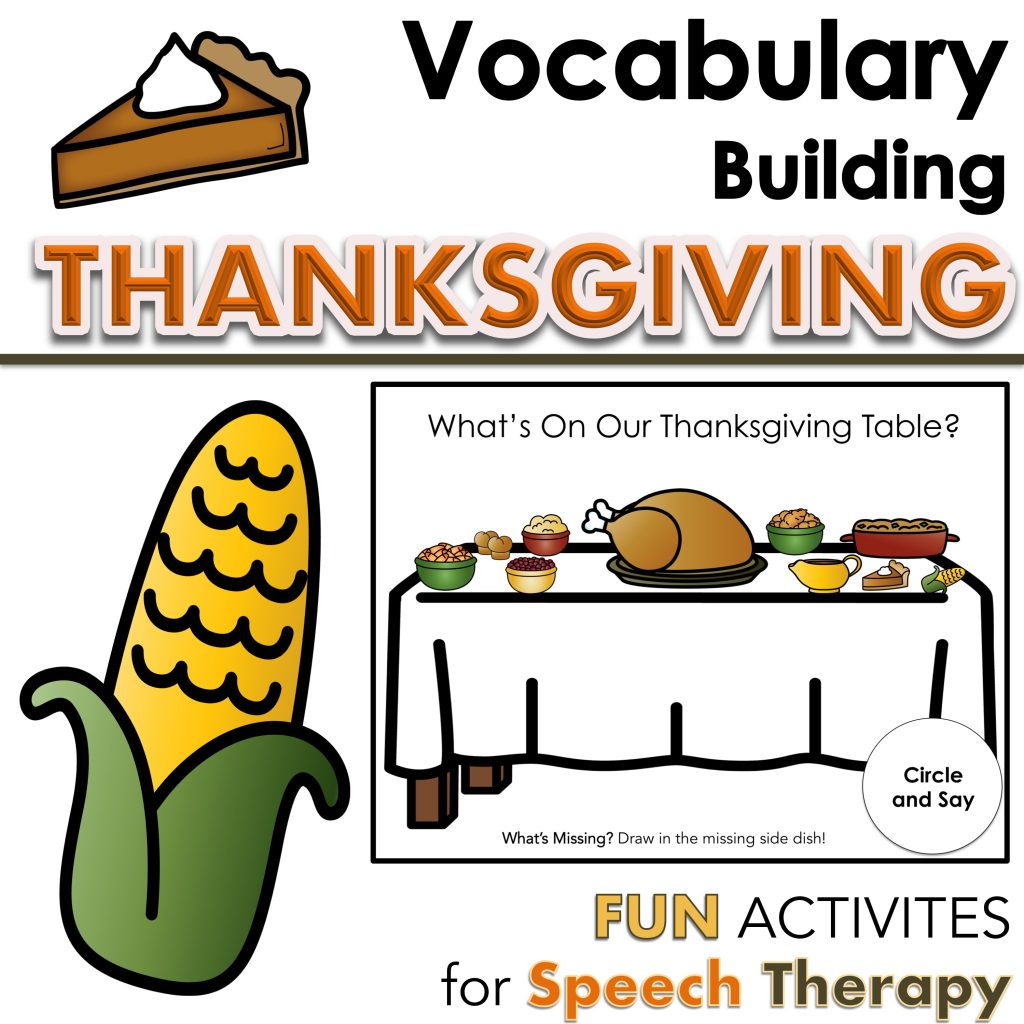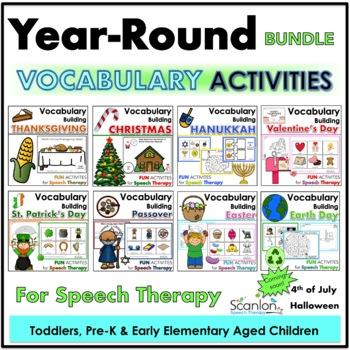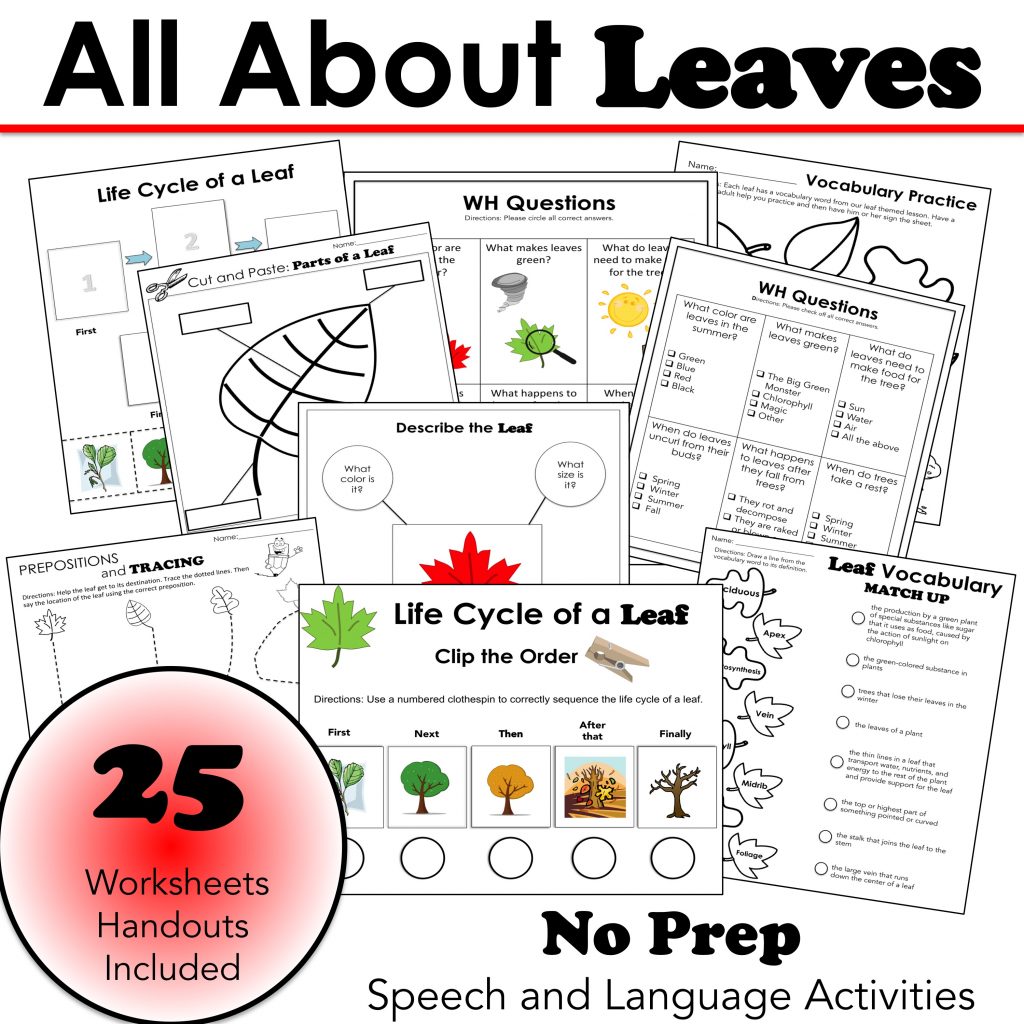Sign Up For Our E-Blast To Receive Information on our Books, Speech Therapy materials and our latest freebies!
Thanksgiving Activities for Speech Therapy

Gobble gobble. Thanksgiving is a time of gratitude, family, and good food. I try to teach my children the value of expressing gratitude and realizing that we are a part of something much bigger than just ourselves.
I’ve gathered a few of my favorite Thanksgiving-themed activities, books, and crafts for you and your child to enjoy this holiday season! Many of these activities and worksheets are from my Thanksgiving Food Vocabulary Packet, which is LOADED with fun activities to provide toddlers, preschoolers and young elementary students with exposure to the various foods and objects traditionally seen on Thanksgiving Day. Check them out below!
Affiliate links have been included.
Read Some Books About Thanksgiving

Reading is a powerful way to improve your child’s vocabulary and speech skills! I love reading holiday-themed books to introduce my children and clients to new vocabulary words. Here are some of my favorite Thanksgiving-themed books:
“There Was an Old Lady Who Swallowed a Turkey” by Lucille Colandro. What hasn’t the old lady swallowed?! This popular book series is one of my favorites to read with my preschool and school-aged clients, and this particular one is perfect for Thanksgiving. Apart from their seasonal value, these books can be used to target a variety of language skills 🗣.
You can practice repetition, sequencing events (first, next, before, after, last), and making predictions. And, I love using these books to practice the “l” sound! This book is a perfect way to blend the holiday spirit and speech practice!
‘Twas The Night Before Thanksgiving by Dave Pilkey. is a great selection to use in speech therapy sessions because it targets a variety of speech and language goals, including:
Articulation: Many opportunities to practice the following target sounds, such as /p/, /b/, /t/, /d/, /k/, /g/, /f/, and /s/.
Vocabulary: A variety of new vocabulary words, such as “coop,” “cockerel,” “giggle,” “gobble,” and “gravy” are introduced in this story.
Sequencing: The book tells a story of a group of children visiting a turkey farm on the day before Thanksgiving. Have the students retell the story in sequence, using pictures or other visual cues.
Comprehension: Ask questions about the story to check students’ comprehension, such as “What did the children do on the turkey farm?” and “Why did the children take the turkeys?”
Perspective-taking: The therapist can ask the child to consider the different perspectives in the story, such as the children’s perspective, the turkeys’ perspective, and Farmer Mack Nuggett’s perspective. This can help the child develop their empathy and social skills. For instance, as a turkey eating person, I felt a little badly for Farmer Mack but he also shouldn’t have brandished the ax!
Problem-solving: Encourage students to think about how the children in the story could have solved their problem in a different way. This helps them develop their critical thinking skills.
Making good choices: Discuss the choices that the children made in the story and help the student to understand why some choices were better than others. This can help the child develop their decision-making skills.
“Five Silly Turkeys” by Salina Yoon. It has rhythm, rhyme, and repetition that begs children to shout words when reading. The toddler can also help turn the page with the book’s grabbable foil feathers.
“Where is Baby’s Turkey” by Karen Katz. The vocabulary in this book is a bit more advanced than Yoon’s book but provides the young child exposure to words associated with the Thanksgiving holiday in an age appropriate manner.
Color and Say and Circle and Say: What’s On Our Thanksgiving Table?

Grab some markers, crayon, and colored pencils and have your child color in their favorite Thanksgiving dishes in this fun and unique Color and Say Activity! As they’re coloring, have them say the word of the food they are coloring. For example, if they are coloring in the turkey, have them say “Turkey”. Also try asking them questions such as, “What’s your favorite Thanksgiving food?” or “What is the name of this dish?” A Circle and Say Worksheet is also available in my Thanksgiving Food Vocabulary Activities Product. This product contains 42 pages of downloadable worksheets, flashcards, puzzles, and more to use at home, in your classroom, or during your speech therapy sessions!
Simple Strainer and Feather Activity

Grab a strainer and some craft feathers and have your children push and pull the feathers in and out!
“In”, “Out”, “Push”, “Pull”, “Where did they go?”, “Feather”, and “Tickle” are just some words to target while doing this simple feather activity. Grasping the feather and trying to insert the feather’s tip into the hole is a great way to also target the phrases, “help” or “help me”, while concurrently developing those fine motor skills.
Vocabulary Puzzles

Use these interactive vocabulary puzzles with your child to practice their Thanksgiving vocabulary skills! Print, laminate, and cut out these puzzle pieces, and begin by spreading them out on the table or floor. Then, have your child put the pieces together! This provides a wonderful context to talk about the different food!
Hand Turkeys

Have some fun with your little one and make hand turkeys for Thanksgiving! First, trace you and your child’s hand, then draw lines separating the fingers from the palm to create the “feathers”, and finally color and decorate your turkey!
This activity is EASY, and it helps your child practice vocabulary, colors, and animals (turkey). Feel free to add googly eyes, sparkles, or any other decorations that will liven up your hand turkey!
Say, Color, and Display Coloring Sheets

Coloring. For the times when a breather is needed, break out these Color, Say, and Display coloring sheets. Each sheet has one food item traditionally eaten on Thanksgiving. These are great for not only reviewing vocabulary words and generating sentences but also for articulation practice!
WHAT DO YOU LIKE TO EAT? Or WHAT WILL YOU TRY?

Some traditional Thanksgiving food consists of turkey and gravy, mashed potatoes, sweet potatoes, stuffing, green beans, cranberries, biscuits, and pumpkin pie. I don’t know about you, but I LOVE homemade stuffing. Thanksgiving is usually the only time of year I get to enjoy it. This cornucopia of food is not what many children eat on a regular basis so some may be hesitant to try them.
I can’t help but think of my daughter’s favorite literary character, Junie B. Jones and the book, Turkeys We Have Loved and Eaten (and other Thankful Stuff). In this book, Junie’s teacher, Mr. Scary is excited to tell the class that the winner of the school Thankful Contest will get a homemade pumpkin pie baked by their “very own lunch lady Mrs. Gladys Gutzman”. Although to his dismay, his students are disgusted by this prospect and respond with, “Pumpkin pie makes me vomit” and “My grandmother’s pumpkin pie sits in my mouth like a big wad of goop glop”. I can’t help but chuckle because this was NOT the reaction Mr. Scary had anticipated. Furthermore, their forthright disgust of pumpkin pie united the class! From the perspective of a speech language pathologist, it’s important to talk about, describe, and explain likes and dislikes because it provides opportunities to compare and contrast items and discuss opinions in a respectful manner.
I hope this post has been helpful, and if you try any of these activities please share a picture and tag me because I would love to see them!
Happy Thanksgiving!
- Enhance Your Speech Therapy Sessions with ‘Picky Kitty’ – A Must-Have Game for Every Speech Therapist
- Same and Different: Why Speech Therapists and Educators Should Target this Basic Concept
- New Beginnings for Scanlon Speech Therapy
- Articulation Speech Therapy: Favorite Activities, Games, and Books to Target the TH Sounds
- Articulation Speech Therapy: Favorite Activities, Games and Books to Target the L Sound



